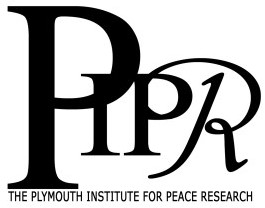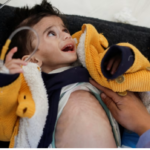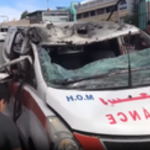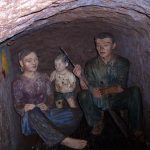The 7/7 Conspiracy: Ten Years Later, Still No Justice
By T.J. Coles
4 July, 2015
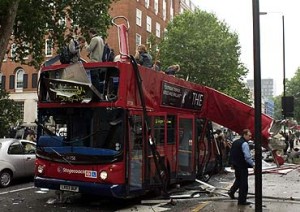
Survivors on the top deck? Can explosives tear through metal but not flesh?
Following the attacks in Tunisia, Britons prepare to remember the 52 civilians who perished in terrorist attacks in London on 7 July, 2005. To date, there has been no public inquiry into the 7 July 2005 bombings, despite calls for one by survivors and victims’ relatives.1
CAUSE OF DEATH “NOT APPLICABLE”
To date, no posthumous trial has been held to convict the four suspects. (Three alleged accomplices were put on trial and found not guilty of involvement in the 7 July attacks.)2 The deceased suspects are Hasib Hussain, Mohammed Siddique Khan (the alleged ringleader), Jermaine Lindsay, and Shehzad Tanweer (all presumed dead).
After public pressure, a mockery of an inquest was held in 2010-11, led by Lady Justice Hallett acting under the advice of a Ministry of Defence (MoD) Colonel who specialised in anaesthesia. Hallett’s inquiry was closed to the public and the report is a mere 65 pages in length. It contains no publicly available sources. It spends an inordinate amount of time (citing an anonymous witness) on the background of just two of the suspects and on the response of the emergency services.3
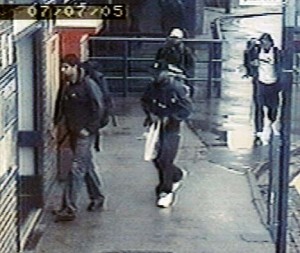
Only one of the alleged bombers is identifiable from CCTV.
During Hallett’s so-called inquest into the murder of 52 people, no autopsies were conducted (‘the decision was taken not to hold internal post-mortem examinations of the 52 victims’.4
Hallett relied on the MoD Colonel’s opinion: that the 52 individuals had died as a result of explosions. No forensic evidence was published concerning the nature of the explosions or explosives. It was widely reported by the police that homemade hydrogenperoxide bombs were used in the attacks. As we shall see, however, terrorism experts believe the explosives were military-grade.
Hallett chose not to include the suspects in her inquest. If four suicide bombers had been present/responsible for the atrocities, the total number of dead would be 56. The inquest does not confirm that Hussain, Khan, Lindsay, or Tanweer died and puts the number of dead at 52. This is official and inadvertent recognition that no suicide bombers were present or indeed perished on 7 July, 2005.
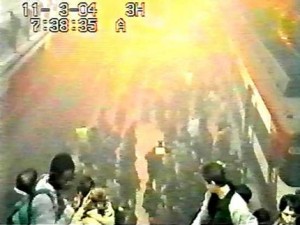
Madrid bombing, 2004. Notice the fireball.
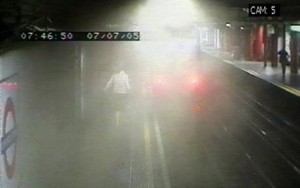
7/7 bombing. Notice the absence of a fireball. Also notice the timestamp on the 7/7 image: an hour before the bombs were alleged to have gone off.
The Hallett report does not attribute the murder of any of the 52 persons to Hussain, Khan, Lindsay, or Tanweer. Hallett dedicates two pages to each of the 52 victims in a separate submission to the Government, all of which state: ‘the death of the deceased was caused or contributed to by: N/A’. Can you imagine losing a loved one on 7 July 2005 and reading that the cause of death is ‘not applicable’?5
Angered and saddened, many of ‘The relatives called on the Government to launch a public inquiry because the inquest raised ‘a lot more questions to be asked than it did answers’’.6
FRAMING THE INNOCENT: FROM THE BIRMINGHAM SIX TO AL-MEGRAHI
The UK media and justice system have a record of holding innocent people responsible for terrorism. There is a long history of collaborations and conspiracies between police, forensic specialists, coroners, prosecutors, and media to frame individuals by forcing confessions and planting and tampering with evidence. In fact, framing innocent people for terrorism is not only common in the UK, it is quite normal. Why should the 7/7 bombings be any different? To give some well-known examples:
Judith Ward. In 1973, Euston Station was bombed. In 1974, the National Defence College and a bus travelling along the M62 were bombed. 12 people were killed in the bus attack. A mentally unstable woman, Judith Ward, was arrested and framed for the bombings. She was released in 1993 after her conviction was quashed.7
Guilford Four and Maguire Seven. In October 1974, the Provisional IRA detonated bombs in Woolwich and Guilford, killing eight people. Four innocent individuals, including a 17-year-old girl (Carole Richardson), were arrested and tortured by British police into confessing. An innocent family and their associates (the ‘Maguire Seven’) were later arrested for possessing nitroglycerine. The police withheld information, tampered with evidence, and tortured some of the seven individuals. The former served 15 years’ imprisonment, the later served 16.8
Birmingham Six. In November 1974, 21 people were murdered in Birmingham in two separate bomb attacks. Six men were arrested, tortured, subjected to mock executions, and had their families threatened by British police. Like the above, they were released (having served 16 years).9
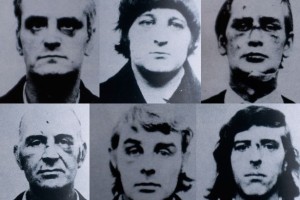
Birmingham Six, police brutality.
Danny McNamee. In 1986, 26-year-old Danny McNamee was arrested by British occupation forces (the Army and the RUC) and sentenced in London to 25 years’ imprisonment for conspiracy to cause explosions. His conviction was overturned in 1998. The QC at the Court of Appeal said that McNamee was a victim of prejudice and that evidence in the original trial had been deliberately withheld.10
Abdelbaset al-Megrahi. In December 1988, 270 people were murdered when Pan Am Flight 103 exploded in a terrorist attack over Lockerbie, Scotland. Megrahi was framed for the murders. A letter signed by 42 prominent individuals, including peers, police, victims’ relatives, QCs, and others (see footnote), notes ‘a multitude of serious question marks over material evidence, including the very real possibility of the crucial fragment of PCB having been fabricated; discredited forensic scientists testifying for the prosecution; Crown witness testimony being retracted after the trial and, most worryingly, allegations of the Crown’s non-disclosure of evidence which could have been key to the defence. Added to which, evidence supporting the alternative and infinitely more logical ingestion of the bomb directly at Heathrow was either dismissed at the trial or withheld from the court until after the verdict of guilty had been returned’.11
EVIDENCE HIDDEN
In keeping with the pattern outlined above, evidence was planted, destroyed, withheld, and/or tampered with on or after 7 July 2005.
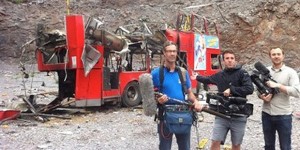
BBC’s conspiracy road trip blows up bus.
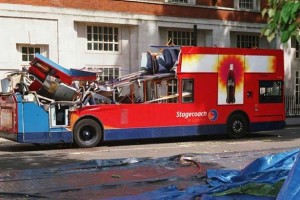
7/7 bus showed no signs of being exploded, but cut open.
Evidence withheld. The Metropolitan Police began its biggest operation to date, Operation Theseus, which includes 29,500 exhibits, 13,000 witness statements, and 6,000 CCTV images. Little of Theseus has been released to the public. A recent Freedom of Information Act request filed by this author to obtain the Theseus files was rejected with a Refusal Notice on the grounds of ‘national security’. The Metropolitan Police’s response was that releasing information from Theseus was Hallett’s prerogative.
The Home Office’s Report of the Official Account of the Bombings in London on 7 July 2005 (2006, The Stationary Office) includes no sources or verifiable witnesses and states that ‘Some material has been withheld to avoid prejudicing current or possible future prosecutions, the ongoing police investigation, to protect intelligence relationships, sources and techniques and to avoid providing information that could help future terrorists’ (p 1). The Intelligence and Security Committee’s report Could 7/7 Have Been Prevented? (2009, The Stationary Office) cites ‘instances where the courts have ruled that information cannot be published’ (p. iii).

Having appeared on BBC Panorama’s London Under Attack in 2004, in which bomb attacks on three tube trains and a road vehicle were simulated, Visor Consultants’ Peter Power ran a crisis simulation exercise on 7 July, 2005, in which ‘precisely the same’ stations were bombed as happened in real-life.
By 2008, just three CCTV stills had been released to the public: none of which show Khan et al. together in London. (In the Luton Station photo, discussed below, only Hussain can be positively identified.) The footage released in the trial of Khan et al.’s alleged accomplices (Waheed Ali, Sadeer Saleem, Mohammed Shakil) is contradictory and only undermines the Government’s case:
The cancelation of the 07.40 to Luton means that Khan et al. could not have arrived in time to carrying out the bombings. The revised Government narrative does not correspond to the latest CCTV releases. The time of one of the tube explosions is stamped 07.50 (an hour earlier than the official explosion).12
After the bombings, five French counterterrorism specialists were invited by the Metropolitan Police to investigate the attacks. Christophe Chaboud, head of France’s Anti-Terrorism Coordination Unit, informed the British media that, ‘Among the victims, many of the wounds [lesions] were in the lower limbs, indicating that the explosives were placed on the ground, perhaps under the seats’, tallying with earlier eyewitness statements that explosions came from beneath the carriages. ‘The type of explosives appear to be military’, said Chaboud.13
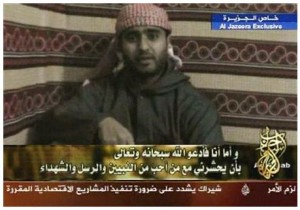
The suspects’ ‘martyr’ videos have never been shown in their entireties, and no one knows how the police acquired them.
Numerous survivors (including Dr Gerardine Quaghebeur) reported being electrocuted.14 This narrative was changed after the New York Police Department rapidly assessed the scene and claimed that the bombs were bleach-based.15 (Though taken, the eyewitness statements of Quaghebeur et al. are not included in the Hallett report).
These important details were reported once in two newspapers and expunged from the Government narrative.
Foreign media reported deaths by armed police at Canary Wharf on the morning of 7 July 2005. There has since been a cover-up to deny that any such shootings took place. (See note 12).
Following her arrest and detention for five days, evidence was withheld by police from Khan’s widow Hasina Patel, namely an alleged suicide note and will written by Khan, which would have cleared her of involvement in the bombings.16
TAMPERED EVIDENCE
Evidence destroyed. Contrary to their claims, the police carried out controlled explosions on at least one of the tube carriages and on devices found on the No. 30 bus. The tube carriages and No. 30 bus were scrapped after the explosions, preventing independent experts from examining the crime scenes. Prior to its being scrapped, the No. 30 was cut into pieces. Photographs after the explosion show the sides of the bus split outwards and subsequent stills show them removed. (Perhaps it is a coincidence that a van from the controlled demolition firm Kingstar, which specialises in demolition by cutting, was parked next to the No. 30 bus as it allegedly exploded?)17
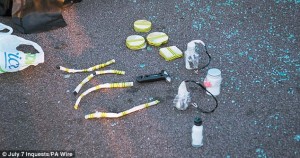
Bombs supposedly left behind.
Somehow, ABC News (America) obtained photographs of bombs purportedly left behind by the 7/7 bombers. Why would suicide bombers leave bombs behind? BBC News Online later reported that the evidence had been destroyed by police in controlled explosions.18
Evidence planted. According to the Metropolitan Police, one of the bombers appeared in two separate locations at the same time. Peter Clarke, head of the Counter Terrorist Command, informed the press that ‘in relation to a third man, property in his name was found at the scene of both the Aldgate and the Edgware Road bombs’.19
Evidence tampered with. The faces of Khan, Lindsay, and Tanweer are blurred in the Luton Station CCTV still. The two other stills released prior to 2008 have no dates or timestamps and have been inexplicably cropped. Even the appalling Hallett report complains (in relation to earlier stills) that ‘poorly cropped photographs were used and there is no satisfactory explanation for this having happened. I fully expect the Security Service to review their procedures to ensure that good quality images are shown and that whatever went wrong on this occasion does not happen again’ (Hallett 2006, pp. 16-17).
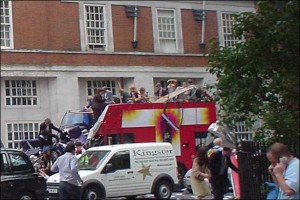
How can survivors be on the top deck, unscathed? Cutting specialists Kingstar present at the scene.
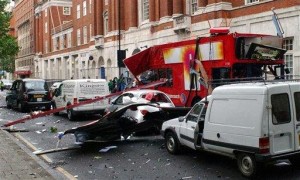
The driver of the van lied and said that the back of his vehicle was severely damaged in the explosion, but this angle shows no damage.
Similarly, the so-called Khan and Tanweer confession videos have never been shown in their entireties and were released to the media—with no dates or timestamps—by ‘al-Qaeda’ (by whom? To whom? When? How?) Tanweer is reading from a piece of paper, as if from a script, and makes numerous references to Muslim brothers and sisters being killed all over the world by the West. Neither he nor Khan references suicide bomb attacks.
CONCLUSION
Until the majority of citizens realise that their own internal ‘security’ services use ruthless means to support government foreign policy and the interests of big business, including the use of false-flag terrorism to justify war, these kind of inside-jobs—and the evidence points to 7/7 being an inside-job—will continue.
This article is adapted from The New Atheism Hoax, available at www.pipr.co.uk/ebooks
NOTES
- BBC News Online, ‘Call for public inquiry into 7/7’, 15 August, 2005,
https://news.bbc.co.uk/1/hi/uk/6948174.stm . For the scandalous response, see Esther Addley, ‘7/7 survivors end battle for public inquiry into bombings’, Guardian, 1 August, 2011, https://www.theguardian.com/uk/2011/aug/01/7-july-bombings-public-inquiry , states: ‘Survivors and relatives of those who died in the 7 July bombings have abandoned their legal attempt to force the government to hold a public inquiry into the attacks, acknowledging that proceedings would be likely to be unsuccessful and would cause “further unnecessary distress”’.
- Rachel Williams, ‘Trio not guilty of helping 7/7 London bombers’, Guardian, 28 April, 2009, https://www.theguardian.com/uk/2009/apr/28/july-7-london-bomb-trial
- Lady Justice Hallett, ‘Coroner’s Inquests into the London Bombings of 7 July 2005’, 6 May, 2011, The Stationary Office.)
- Hearing Transcripts, ‘Closing remarks’, p. 19, https://www.julyseventh.co.uk/j7-inquest-transcripts/2011-05-02-06-week-21/7_july_inquests_2011-05-06_am-session.pdf
- Lady Justice Hallett, ‘Inquisition forms’, https://webarchive.nationalarchives.gov.uk/20120216072438/https://7julyinquests.independent.gov.uk/directions_decs/inquisition-forms.htm ).
- Arthur Martin and Vanessa Allen, ‘‘They were never given a chance’: Fury of the 7/7 families whose stricken loved ones fought for their lives’, Daily Mail, 7 May, 2011.
- Judith Ward, 1993, Ambushed: My Story, Vermillion.
- Gerry Conlon, 1994, Proved Innocent: The Story of Gerry Conlon of the Guildford Four, Penguin and Clive Walker and Keir Starmer (eds.), 1999, Miscarriages of Justice: A Review of Justice in Error, Blackstone Press and Oxford University Press, pp. 54, 132-3.
- Chris Mullin, 1990, Error of Judgement: The Truth About the Birmingham Bombings, Poolbeg Press.
- Michael Mansfield, 2010, Memoirs of a Radical Lawyer, Bloomsbury, pp. 38-9, 41.
- Robert Forrester, ‘Scotland must now have the courage to look itself in the mirror: An open letter from 42 signatories’, no date, Scottish Review, https://www.scottishreview.net/RobertForrester273.shtml
- For a scholarly analysis of these serious inconsistencies, see ‘Theorising Truth: What Happened at Canary Wharf’ by Sheffield Hallam University’s Dr. Rory Ridley-Duff (2009, https://www.scribd.com/doc/20833633/What-Happened-at-Canary-Wharf-on-7th-July-2005
- Richard Norton-Taylor and Duncan Campbell, ‘Terror cell ‘capable of further attacks’’, Guardian, 12 July, 2005, https://www.theguardian.com/uk/2005/jul/12/july7.politics
- Independent, ‘Voices of 7/7: The survivors’ testimonies form a searing but inspiring memorial to the 52 victims’, 4 March, 2011, https://www.independent.co.uk/news/uk/home-news/voices-of-77-the-survivors-testimonies-form-a-searing-but-inspiring-memorial-to-the-52-victims-2231571.html
- Guardian, ‘‘Hair bleach used to make July 7 bombs’’, 4 August, 2005, https://www.theguardian.com/uk/2005/aug/04/july7.uksecurity6
- Vikram Dodd, ‘Police ‘kept bomber’s suicide note from wife’ arrested over 7/7 attack’, Guardian, 28 July, 2007, https://www.theguardian.com/uk/2007/jul/28/july7.uksecurity
- BBC News Online, ‘7 July London bombings’, 5 May, 2011, https://www.bbc.co.uk/news/uk-13301195 and Hugh Muir and Rosie Cowan, ‘Four bombs in 50 minutes – Britain suffers its worst-ever terror attack’, Guardian, 8 July, 2005, https://www.theguardian.com/uk/2005/jul/08/terrorism.july74 . ‘Police denied that they had recovered any unexploded devices. But a source told The Guardian that three controlled explosions had been carried out on “suspect devices”. Furthermore Vincent Cannistraro, the former head of the CIA’s counter-terrorism centre [sic], told The Guardian that “two unexploded bombs” were recovered as well as “mechanical timing devices”’. See also BBC News Online, ‘In pictures: Number 30 bus bomb aftermath’, no date, https://news.bbc.co.uk/1/shared/spl/hi/pop_ups/05/uk_number_30_bus_bomb_aftermath/html/3.stm . ‘Police say the bomb exploded on the top deck of the bus but this picture shows that many of those at the front were unscathed’. Compare with the picture in Press Association, ‘Survivor tells inquest of losing friend on Tavistock Sq. bus’, Guardian, 25 January, 2011, https://www.theguardian.com/uk/2011/jan/25/7-july-bombs-friend-tavistock
- BBC News Online, ‘In Pictures: Bombs left behind’, 30 June, 2006, https://news.bbc.co.uk/1/hi/in_pictures/5109048.stm
- BBC News Online, ‘Police news conference: Full text’, 12 July, 2005, https://news.bbc.co.uk/1/hi/uk/4676909.stm
